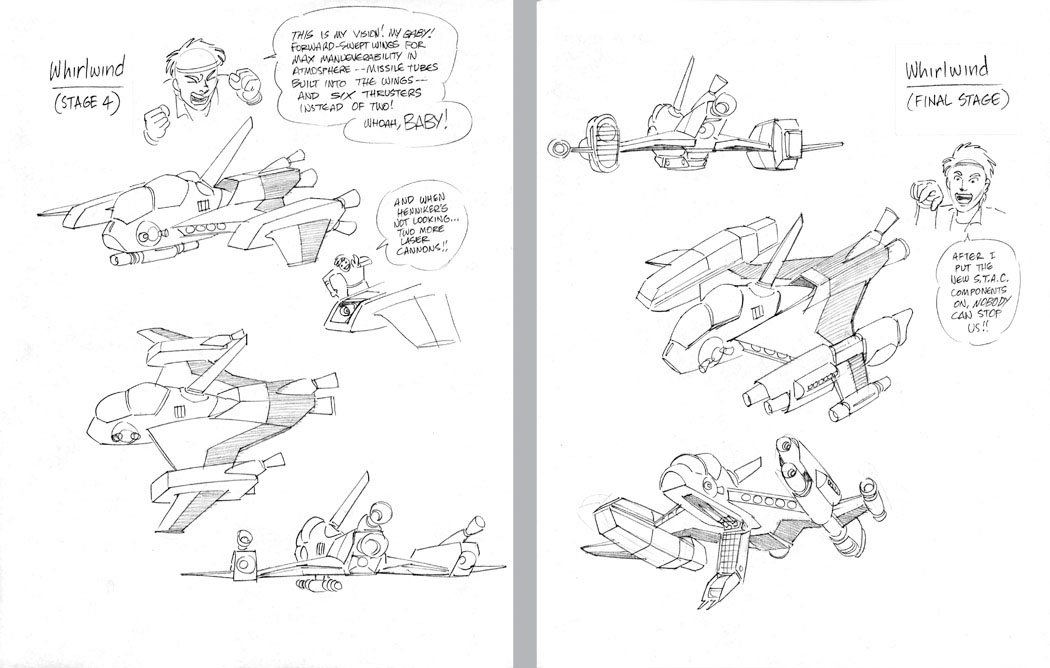As explained in the “Whole History” article, one of my early goals for Grease Monkey was to explore its viability as an animated TV series. My pursuit of this goal got its first results in 1995 when a chain of events initiated by Kitchen Sink Press got me some face time with various executives at various studios. It was necessary to create a presentation package with new artwork that explained the story at a glance. Coupled with an verbal explanation by animation writer Jymn Magon, they allowed me to project forward past the first six comic episodes into an expanded story that would work on TV.
The first studio to bite was actually the last one we saw, Universal. They liked my work enough to hire me as a storyboard artist AND character designer for Wing Commander Academy, an SF action-adventure series that was right up my street (13 episodes were broadcast on USA Network). This turned out to be the first of many animation gigs that took me all the way up to today (as of 2014 I’m a director on Avengers Assemble for Marvel) and I’ve never forgotten that Grease Monkey is what made that possible.
Here are the images that were presented for consideration.
The setup for the story: the alien horde invades Earth and nearly wipes it out. The benefactors arrive to accelerate gorillas and the planet recovers. The Fist of Earth is built and takes off into space to find the horde.
Meet our main characters: young cadet mechanic Robin Plotnik arrives on board and meets his new boss, chief mechanic Mac Gimbensky. It doesn’t go well at first.
But over time, the two find they have some things in common, like an eye for the ladies and a special talent for finding trouble.
Space battles are a daily occurrence as the squadrons train against each other – and the hottest squadron of them all is an all-female unit called the Barbarians.
Barbara Brand is the ice-cold squadron leader – Mac and Robin are responsible for keeping her fighters in top condition. Valerie Diaz is her fire-hot second in command, and everything is flipped on its head when rookie Kim Barnett shows up ready to fly.
I hadn’t drawn Kara Soki in the comics yet, but in fact she was invented before Kim. The art at left was drawn “on spec” in case we found a way to include her, but in the end her role was limited to Book 1. At right is the squadron lead by Lyle Brand, Barbara’s smart-ass brother (he’s the REALLY smug one at far right).
The other essentials are Admiral Stettler (the object of Mac’s affections), and Colonel Henniker who lives to make everything harder than it has to be. As the story ideas developed, I hit on the idea of the STAC group, which stands for Strategic Tactical Air Corps.
The three pilots (Lyle, Valerie, and a gorilla named Figgis) would pilot these cutting-edge weapons against the alien horde once enough data was gathered.
If you’ve read Book 2, you know the role the STAC ships played in the story. But you probably didn’t know they had a name.
As those ships were being developed, Robin got to work on his own, which he called Whirlwind. This, too would go on to play an active part in Book 2.
The little cartoons were just me having fun and scoping out a little more of Robin’s character. (Remember, at the time these were drawn, the only comic material that existed were the first six episodes of Book 1.)
The Whirlwind in color, seen here in stage 1 and stage 4 configurations. Stage 4 never actually got used in the story, since the ship went straight from stage 3 to 5. (They were in kind of a hurry.)
You can’t have heroes without villains, and developing the story for animation made it necessary to figure out what they looked like. At left is a representative image of the alien horde with Earth getting beaten up in the background. The central character was originally named “The Ravager,” but I dropped that in favor of “The Renegade” for story reasons that developed in Book 2.
“Grakk” was a word that just popped into my head one day, and since it sounded like a noise these creatures would make, it seemed like a decent name for them. Their flagship has biblical implications when you look at it from the front, and the Grakk fighters are as brutal as their pilots: they’re best at slamming into things.
Three last images to go out on: a second view of Robin Plotnik after he’s grown up a bit, an imaginary scenario of Mac tangling with a Grakk (done to meet a request for a fight scene in the presentation), and a closing title card that revived the first “finished” drawing of Mac and Robin. They still had a long way to go, as did I.


















